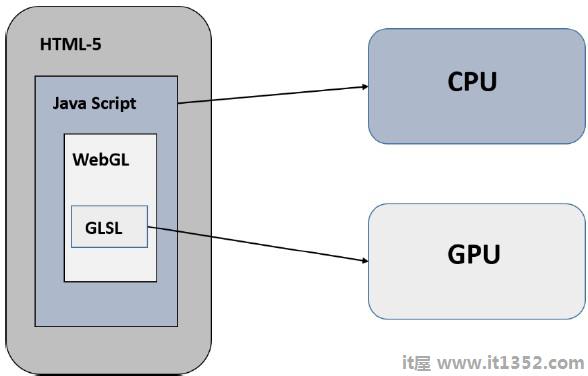我们已经讨论了WebGL和WebGL管道的基础知识(渲染Graphics应用程序的过程).在本章中,我们将使用示例应用程序使用WebGL创建三角形并观察应用程序中遵循的步骤.
WebGL应用程序代码是JavaScript和OpenGL着色器语言的组合.
需要JavaScript与CPU通信
需要使用OpenGL着色器语言与GPU通信.

现在让我们举一个简单的例子来学习如何使用WebGL绘制一个简单的三角形2D坐标.
<!doctype html>
<html>
<body>
<canvas width = "300" height = "300" id = "my_Canvas"></canvas>
<script> /* Step1: Prepare the canvas and get WebGL context */
var canvas = document.getElementById('my_Canvas');
var gl = canvas.getContext('experimental-webgl'); /* Step2: Define the geometry and store it in buffer objects */
var vertices = [-0.5, 0.5, -0.5, -0.5, 0.0, -0.5,];
// Create a new buffer object
var vertex_buffer = gl.createBuffer();
// Bind an empty array buffer to it
gl.bindBuffer(gl.ARRAY_BUFFER, vertex_buffer);
// Pass the vertices data to the buffer
gl.bufferData(gl.ARRAY_BUFFER, new Float32Array(vertices), gl.STATIC_DRAW);
// Unbind the buffer
gl.bindBuffer(gl.ARRAY_BUFFER, null); /* Step3: Create and compile Shader programs */
// Vertex shader source code
var vertCode =
'attribute vec2 coordinates;' +
'void main(void) {' + ' gl_Position = vec4(coordinates,0.0, 1.0);' + '}';
//Create a vertex shader object
var vertShader = gl.createShader(gl.VERTEX_SHADER);
//Attach vertex shader source code
gl.shaderSource(vertShader, vertCode);
//Compile the vertex shader
gl.compileShader(vertShader);
//Fragment shader source code
var fragCode = 'void main(void) {' + 'gl_FragColor = vec4(0.0, 0.0, 0.0, 0.1);' + '}';
// Create fragment shader object
var fragShader = gl.createShader(gl.FRAGMENT_SHADER);
// Attach fragment shader source code
gl.shaderSource(fragShader, fragCode);
// Compile the fragment shader
gl.compileShader(fragShader);
// Create a shader program object to store combined shader program
var shaderProgram = gl.createProgram();
// Attach a vertex shader
gl.attachShader(shaderProgram, vertShader);
// Attach a fragment shader
gl.attachShader(shaderProgram, fragShader);
// Link both programs
gl.linkProgram(shaderProgram);
// Use the combined shader program object
gl.useProgram(shaderProgram); /* Step 4: Associate the shader programs to buffer objects */
//Bind vertex buffer object
gl.bindBuffer(gl.ARRAY_BUFFER, vertex_buffer);
//Get the attribute location
var coord = gl.getAttribLocation(shaderProgram, "coordinates");
//point an attribute to the currently bound VBO
gl.vertexAttribPointer(coord, 2, gl.FLOAT, false, 0, 0);
//Enable the attribute
gl.enableVertexAttribArray(coord); /* Step5: Drawing the required object (triangle) */
// Clear the canvas
gl.clearColor(0.5, 0.5, 0.5, 0.9);
// Enable the depth test
gl.enable(gl.DEPTH_TEST);
// Clear the color buffer bit
gl.clear(gl.COLOR_BUFFER_BIT);
// Set the view port
gl.viewport(0,0,canvas.width,canvas.height);
// Draw the triangle
gl.drawArrays(gl.TRIANGLES, 0, 3);
</script>
</body>
</html>它将产生以下结果 :
如果您仔细观察上述程序,我们已经按照五个连续步骤绘制了使用WebGL的简单三角形.步骤如下 :
步骤1 : 准备画布并获取WebGL渲染上下文
我们获取当前的HTML画布对象并获取其WebGL渲染上下文.
第2步和第2步;定义几何体并将其存储在缓冲区对象中
我们定义几何体的属性,如顶点,索引,颜色等,并将它们存储在JavaScript数组中.然后,我们创建一个或多个缓冲区对象,并将包含数据的数组传递给相应的缓冲区对象.在该示例中,我们将三角形的顶点存储在JavaScript数组中,并将此数组传递给顶点缓冲区对象.
步骤3 : 去;创建和编译着色器程序
我们编写顶点着色器和片段着色器程序,编译它们,并通过链接这两个程序创建一个组合程序.
步骤4 : 将着色器程序与缓冲区对象相关联
我们将缓冲区对象与组合着色器程序相关联.
步骤5 : 号;绘制所需对象(三角形)
此步骤包括清除颜色,清除缓冲区位,启用深度测试,设置视口等操作. ,你需要使用其中一种方法和减去绘制所需的基元; drawArrays()或 drawElements().
本教程将进一步解释所有这些步骤.